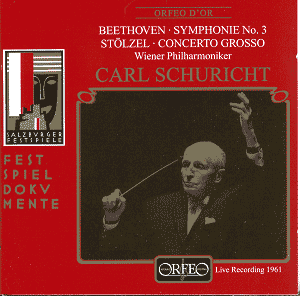It’s hard to believe that this is the Vienna Philharmonic
Orchestra playing the opening work, a rather uninspired Concerto Grosso
by Gottfried Stölzel (1649-1749) played in an ultra-Germanic ponderous
fashion, scrappy in parts rather than ‘vital and energetic’ according
to a contemporary (1961) press report, the concertino soloists only
just managing to keep it going and on the rails. I was reminded of the
Academy of St Martin in the Fields and their breathtaking account of
the contemporaneous Brandenburg Concertos I reviewed for this website
just last week, where the trumpet playing in No. 2 was by way of contrast
to the (admittedly live recording here) spot perfect. Sometimes it is
not always wise to unearth supposedly ‘legendary’ performances, and
it’s a pity that the next item on the programme (Clifford Curzon playing
Mozart’s last piano concerto, No. 27 in Bb K.595) was not issued instead.
However, having disposed of the first ten minutes of this CD, one of
a dozen which Orfeo D’Or have issued of performances from the post-war
Salzburg Festivals 1951-1972, it’s the Eroica which really matters
and with which Carl Schuricht deserves better appraisal.
He was 81 at the time (he lived a further six years)
but still full of sparkle, as this traditional (no first movement repeat
unfortunately) interpretation of Beethoven’s masterpiece reveals. His
is a name which was too often overshadowed by greater contemporaries,
Furtwängler, Kleiber, Krauss, and Knappertsbusch but with them
all dead he enjoyed an Indian summer and developed a late but warm relationship
with the VPO from 1956 until his death in 1967, with memorable performances
of Bruckner symphonies in particular. The playing here is rather unremarkable
and understated, the warm-toned strings and athletic horns in the trio
better than some scrawny woodwind playing from the oboes. It is all
tidily organised if nothing else, but of the reissues listed there are
far more mouth-watering prospects on offer than this.
Christopher Fifield

